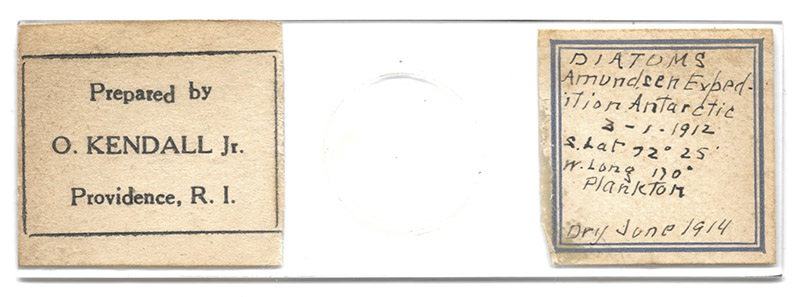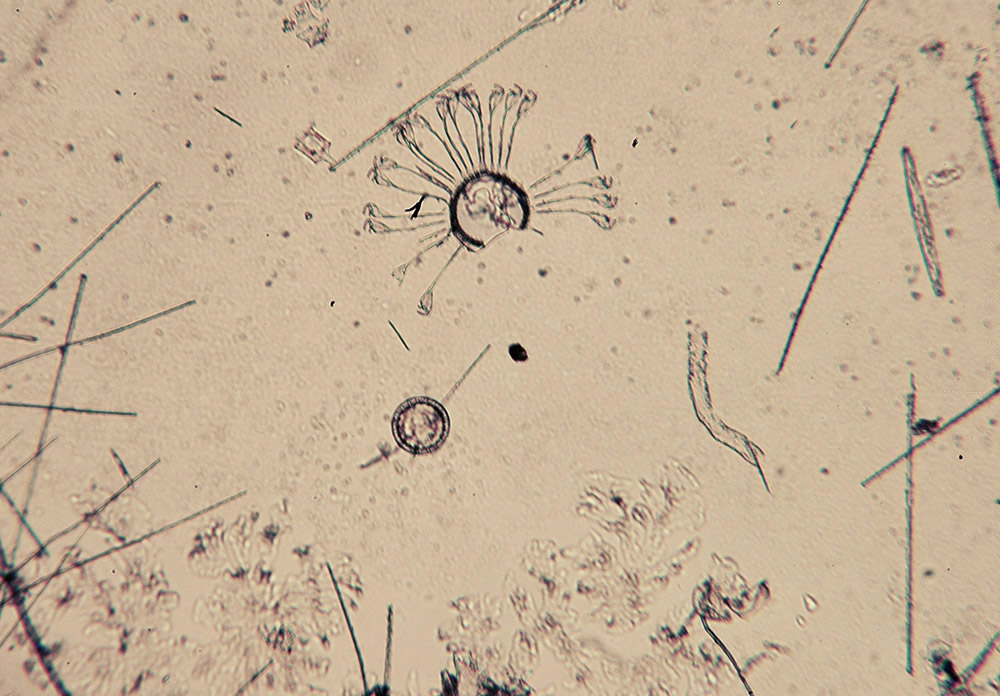Oliver Kendall, 1872 - 1925
by Brian Stevenson
last updated July, 2024
Oliver Kendall lived in Providence, Rhode Island, USA, where he worked as a telphone engineer. He took up an interest in diatoms, and by the early 1900s was considered to be an authority in that field. Several diatom researchers turned to Kendall for help in identifying components of their collections. He wrote papers on how to collect diatoms and methods for mounting flies proboscis, and co-wrote an article on diatom identification. He was sometimes referred to as Oliver Kendall Jr.

Figure 1.
A microscope slide by Oliver Kendall, of “Diatoms, Amundsen Expedition Antarctic, 3-1-1912, S. Lat. 72 o 25’, W. Long. 170o, Plankton”, mounted dry in June, 1914. Roald Amundsen and crew traveled from the Ross Ice Shelf to the South Pole and back between October 19, 1911 and January 25, 1912. The location of this collection is off the coast of the Ross Ice Shelf, so the date must be read as March 1, 1912. Amundsen’s ship reached Hobart, Tasmania, on March 7, 1912. (courtesy of Harold Brundage).

Figure 2.
Photomicrograph of the Amundsen specimen that was mounted by Oliver Kendall (see Figure 1). Imaged with a C-mounted Nikon D70s SLR on a Zeiss Universal microscope (courtesy of Harold Brundage).
Oliver Kendall was born on February 9, 1872, in Providence, Rhode Island. He was the eldest son of Oliver and Caroline Elizabeth (nee Hatch) Kendall. Our microscopist was the fourth Oliver in the Kendall line, and his father the third. Probably due to the grandfather and great-grandfather having passed, our microscopist was often referred to as “Junior” and his father as “Senior”.
Oliver Kendall Sr. (i.e. 3rd) was a relatively well-off owner of real estate. The 1880 national census recorded that the family enjoyed the comforts of a live-in servant.
Our Oliver married Susan Abby Kenyon on October 2, 1894. They had one child, a son who they named Oliver.
Kendall had earned a wide-spread reputation for diatom work by the turn of the nineteenth century:
In 1904, F.C. Clarke wrote on “Diatoms” for The Bulletin of the Southern California Academy of Sciences, and stated, “I have sent samples from Redondo, Santa Monica, Temescal and Los Angeles to Mr. Oliver Kendall of Providence, R.I., and he has returned to me mounted slides of the diatoms”.
L.W. Bailey wrote in 1909 on local diatoms for The Bulletin of the Natural History Society of New Brunswick, and included “The species of Diatoms so far obtained from the localities examined are given in the following lists. In presenting them I desire to express my indebtedness to Mr. Oliver Kendall, Jr., of Providence, R.I., who has not only checked most of them from material sent to him for that purpose, but has also added quite largely to their number”. Kendall later co-wrote a paper with Bailey on the diatoms from Vancouver Island, British Columbia for The Transactions of the Royal Society of Canada.
The Naturalists’ Directory was an efficient means to locate other amateur and professional scientists in a geographical region or a specialty, from which one could arrange exchanges of material and ideas. Kendall’s 1914 and 1919 entries stated that he was interested in recent and fossil diatoms and sought to exchange “slides or samples, prefereably marine or brackish deposits” (Figure 3).
In 1915, Kendall published two articles in The Transactions of the American Microscopical Society, so he was presumably a member. The topics were “Method of collecting diatoms from surface of mud” and “Method of preparing fly's tongue as microscopic object”.
Oliver Kendall died on December 20, 1925, at the age of only 53.
Kendall’s collection of “about 400 samples in jars and vials, and about 1500 prepared microscope slides” were donated to the Roger Williams Park Museum, in Providence, R.I. It includes “freshwater and marine diatoms from around the world, fossil and recent examples, with about 20% from Rhode Island”. Hugh A. Gilmore, and Josephine Lombari wrote two short works about Kendall and his diatom collection in 1983, published by Rhode Island College, but neither appears to be available from worldcat.org or other library sources. Any help in obtaining copies of those works will be greatly appreciated.

Figure 3.
Oliver Kendall’s entry in the 1914 “Naturalists’ Directory”.
Acknowedgement
Thank you to Harold Brundage for images of Oliver Kendall’s Amundsen slide and other insights on this diatomist.
Resources
Bailey, L.W. (1909) Diatoms of New Brunswick, The Bulletin of the Natural History Society of New Brunswick, Vol. 6, pages 387-407
Bailey, L.W., MacKay, A.H. and Kendall, O. (1915). List of diatoms from the eastern shores of Vancouver Island, B.C., Transactions of the Royal Society of Canada, Vol. 9, pages 159-173
Clark, F.C. (1904) Diatoms, The Bulletin of the Southern California Academy of Sciences, pages 43-45
Gilmore, Hugh A., and Josephine Lombari (1983) Catalogue of the Oliver Kendall, Jr. Collection of Diatoms and Related Papers Dealing with the Study of Diatoms in the Early Twentieth Century, Rhode Island College, Providence, R.I., 36 pages, unavailable through known sources
Gilmore, Hugh A., and Josephine Lombari (1983) Oliver Kendall, Jr, and the Nature of Amateur Scientific Endeavor in Providence, Rhode Island at the Turn of the Century, Rhode Island College, Providence, R.I., 51 pages, unavailable through known sources
Hargraves, Paul E. (1997) The diatom collections of Rhode Island, RINHews, Vol. 4, pages 7-8
Kendall, Oliver Jr. (1915) Method of preparing fly's tongue as microscopic object, Transactions of the American Microscopical Society, Vol. 34, pages 52-53
Kendall, Oliver Jr. (1915) Method of collecting diatoms from surface of mud, Transactions of the American Microscopical Society, Vol. 34, pages 53-54
The Naturalists’ Directory (1914) S.E. Cassino, Boston, page 62
The Naturalists’ Directory (1919) S.E. Cassino, Boston, page 90
US census and other records, accessed through ancestry.com


